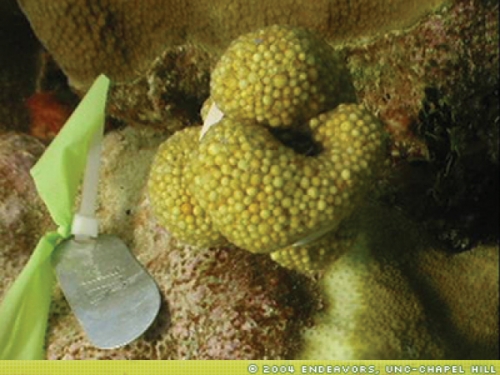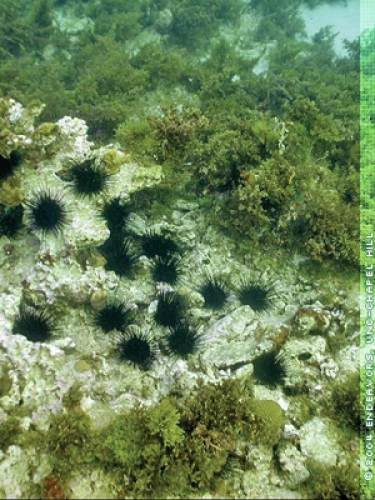What does it take to kill a coral reef? Choose your weapon. Global warming and the hot glare of El Niño. Sewage from cities or chemical runoff from farms. Too much fishing. Disease. That’s a lot of big guns aimed at coral, an unassuming polyp so plantlike by nature that it keeps a little photosynthesis going on the side. All those big guns are blazing. And in each case, the finger on the trigger looks suspiciously human.
Why should we care? A healthy coral reef shelters thousands of species of creatures, from tiny worms to six-foot reef sharks. In some Caribbean countries, two-thirds of the protein in the human diet comes from fishes taken from coral reefs. The reefs attract snorkeling tourists and their vacation money to hard-pressed economies. A reef is a natural breakwater, absorbing wave energy that would batter the coast. And for eons, coral have been laying the groundwork for significant chunks of terrain, including the Yucatan Peninsula of Mexico. Vacationing in Cancun? You’ll dance on the back of a fossil coral reef.
But whatever their benefits, we’re watching the coral reefs die. An estimated 30 percent worldwide are severely damaged, and as many as 60 percent may be dead by the year 2030. Recently, epidemics killed the two most common species of coral on Caribbean reefs, wiping out 60 to 70 percent of the reef area in less than one year. “It was analogous to losing all the pine trees in the Carolinas down to Georgia,” says John Bruno, assistant professor of marine sciences.
Lately, Bruno has found himself squarely in the midst of a minor tempest, because scientists in one camp feel he’s defected to the other side, to a camp that blames environmental problems on various contaminants. Last fall, Bruno reported in Ecology Letters the results of experiments finding that nutrients from chemical fertilizers accelerate coral disease. E-mails from upset scientists hissed with indignation. How dare he? After all, hadn’t he himself held the view that global warming, bleaching, and over-fishing are the real villains?
Yes, he had. He knew what too much heat and sunlight could do to coral. And he knew that fishing had decimated fish populations on many Caribbean reefs — not only carnivorous fish such as snapper and grouper but also the plant-eaters that graze algae and keep it from smothering the reef.
“Ironically, I’ve really been someone who came down on the side that says nutrients are not a major factor in the death of coral reefs,” Bruno says. “We didn’t expect to find what we found.”
He still doesn’t think that nutrients are the biggest factor. But they are big enough. In the summer of 2002, Bruno and his students conducted experiments that showed unequivocally that adding modest amounts of fertilizer greatly accelerates the progress of two deadly diseases of coral. The experiments were the first of their kind.
“People had done correlation studies that showed a statistical relationship between nutrients and coral disease,” Bruno says. “But those results were controversial. And nobody had ever attempted to study this experimentally in the field.”
It’s one thing to crank data through a computer. It’s another thing to spend a summer in scuba gear off the coast of Akumal, Mexico. After carefully establishing the baseline conditions, including the existing levels of nutrients in the water, Bruno and his students worked with nearly 200 sea fans and corals spread across a square kilometer of reef. For three months, the team studied two kinds of diseases in coral: aspergillosis, a fungal disease that kills sea fans (Gorgonia ventalina), and yellow band disease, a bacterial infection that attacks the boulder coral (Montastraea annularis). Every five to seven days, the researchers strapped on their tanks and masks, tipping out of the boat to dive twenty-five or thirty feet down to the reef.
The experimental materials were ingeniously low-tech: panty hose and twenty-five pounds of commercial fertilizer. Fabric from the panty hose made an ideal material for small bags of time-release fertilizer the researchers anchored alongside half of the fans and corals in their study.
“We got some stares when we walked into a store in Mexico and bought fifteen pairs of panty hose,” Bruno says.
As nutrients slowly filtered out through the weave in the hosiery, Bruno and his students watched the yellow rings expanding on the boulder coral, the purple stain of infection advancing across the graceful sea fans. When the team analyzed their data, the results were striking. Coral in healthy, uninfected stands showed no damage from the extra nutrients. But in plots infected with bacteria and fungi, fertilizer nearly doubled the damage by yellow band disease in boulder coral and more than doubled the severity of aspergillosis in sea fans. The implications were clear: even a moderate flow of nutrients from coastal regions could accelerate disease and imperil the coral.
Here’s one scenario, as Bruno describes it. We know that global warming has raised the average summertime water temperature in the Caribbean as much as one degree Celsius (1.8 degrees Fahrenheit) over the last fifty years. And there’s plenty of evidence that warmer water throws the ecosystem out of balance, stressing the coral and creating conditions that favor bacterial and fungal disease. In the tropical Pacific increasingly intense El Niño events have caused widespread coral mortality by raising water temperatures one to three degrees Celsius, causing the corals to “bleach” and possibly lowering their resistance to infection.
All of this is bad enough, Bruno says, to set off spells of disease and decline in the coral. But if you add a dose of nutrients, in the form of, say, sewage or chemical fertilizer, you feed the bacteria and the fungi and accelerate disease.
Where do the diseases come from? The possibilities are many. Spores of aspergillus fungi ride dust particles blown into the Caribbean by storms boiling out of Africa. These dust storms, intensified by deforestation, also airlift quantities of iron in the dust, and iron is another nutrient that can feed a system teeming with disease. Other experts have speculated that land-clearing in the forests of Costa Rica, Honduras, and southern Florida unleashes pathogens into the waters and winds. Disease-causing bacteria also occur in human waste. So when cities inject their sewage into the porous old limestone under the Yucatan Peninsula, nutrients and pathogens may migrate with groundwater and flow to the reef. Or ships using the Panama Canal may release the pathogens in their bilge water.
The pathogens are so numerous, and the patterns of weather and currents so complex, that it has been difficult to pin down the source. Some of Bruno’s colleagues are sequencing samples of the pathogens’ DNA to help identify their origins.
“The bad news is that nutrients can make the diseases worse,” Bruno says. “The good news is that nutrients are something we can control.” Reversing global climate change, he points out, would require long-term commitments from industrialized nations around the world. But individual communities and governments can regulate the discharge of nutrients with good results. In fact, resource managers from several Caribbean nations have contacted Bruno with just such measures in mind.
The other good news is that some species of coral are demonstrating an ability to bounce back from outbreaks of disease. While slow-growing, reef-building types such as the boulder coral may never recover, at least in our lifetimes, fast-growing types such as the staghorn coral are showing more resilience in some locations. “So I’m somewhat optimistic that we can protect some of these reefs,” Bruno says, “if Caribbean countries can find ways to control nutrient pollution.” Doing so will require an ability to predict where the nutrient loads will be heaviest and where they will endanger the reefs. This summer, Carolina Ph.D. student Elizabeth Selig will begin an ambitious project to analyze the risk of nutrient pollution in the Caribbean. Using satellite images that map water temperatures and land uses, Selig will correlate a range of environmental factors with incidence of coral diseases. Large coastal developments or the proliferation of golf courses, for instance, may generate nutrient loads that could imperil a reef. The team will also return to Mexico for more experiments, using outdoor aquaria to study coral bleaching and the effects of temperature on coral disease. Meanwhile, Bruno wants people to understand what’s at stake. “The reefs in the Caribbean are three to five thousand years old,” he says, “and some individuals are themselves hundreds or thousands of years old. These are the ocean’s version of the giant redwoods. And we’re losing them.”
Neil Caudle was the editor of Endeavors for fifteen years.






